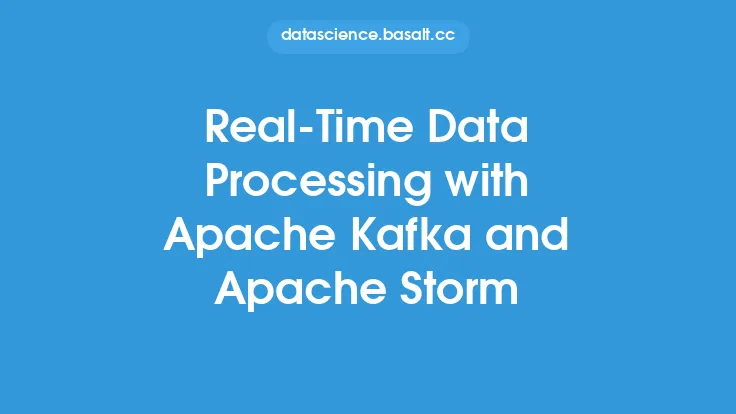The ability to analyze and gain insights from data in real-time has become a crucial aspect of modern businesses and organizations. With the exponential growth of data being generated every second, the need to process and analyze this data in real-time has become more important than ever. Real-time analytics is the process of analyzing and gaining insights from data as it is being generated, allowing organizations to make informed decisions and take immediate actions. In this article, we will delve into the world of real-time analytics, exploring its benefits, challenges, and the technologies that make it possible.
Introduction to Real-Time Analytics
Real-time analytics is a subset of data analytics that focuses on analyzing data as it is being generated, rather than analyzing historical data. This allows organizations to gain insights and make decisions in real-time, rather than waiting for hours, days, or even weeks for the data to be processed. Real-time analytics is made possible by the use of advanced technologies such as in-memory computing, distributed computing, and streaming data processing. These technologies enable organizations to process and analyze large amounts of data in real-time, allowing them to respond quickly to changing market conditions, customer needs, and other factors.
Benefits of Real-Time Analytics
The benefits of real-time analytics are numerous and well-documented. Some of the most significant benefits include:
- Improved decision-making: Real-time analytics enables organizations to make informed decisions based on up-to-the-minute data, rather than relying on historical data that may be outdated or irrelevant.
- Increased efficiency: Real-time analytics allows organizations to automate many processes, freeing up staff to focus on higher-value tasks and improving overall efficiency.
- Enhanced customer experience: Real-time analytics enables organizations to respond quickly to customer needs and preferences, improving the overall customer experience and increasing customer loyalty.
- Competitive advantage: Organizations that use real-time analytics are able to respond quickly to changing market conditions, giving them a competitive advantage over organizations that rely on traditional analytics methods.
Challenges of Real-Time Analytics
While real-time analytics offers many benefits, it also presents several challenges. Some of the most significant challenges include:
- Data volume and velocity: Real-time analytics requires the ability to process and analyze large amounts of data in real-time, which can be a significant challenge for many organizations.
- Data quality: Real-time analytics requires high-quality data that is accurate, complete, and consistent. Poor data quality can lead to inaccurate insights and poor decision-making.
- Complexity: Real-time analytics requires the use of advanced technologies and complex systems, which can be difficult to implement and manage.
- Security: Real-time analytics requires the ability to secure large amounts of data in real-time, which can be a significant challenge for many organizations.
Technologies Used in Real-Time Analytics
Several technologies are used in real-time analytics, including:
- In-memory computing: In-memory computing allows organizations to store and process data in the memory of a computer, rather than on disk. This enables faster processing and analysis of data.
- Distributed computing: Distributed computing allows organizations to process and analyze data across multiple computers or nodes, enabling faster processing and analysis of large amounts of data.
- Streaming data processing: Streaming data processing allows organizations to process and analyze data in real-time, as it is being generated. This enables organizations to respond quickly to changing market conditions and customer needs.
- NoSQL databases: NoSQL databases are designed to handle large amounts of unstructured or semi-structured data, making them well-suited for real-time analytics applications.
- Cloud computing: Cloud computing enables organizations to quickly scale up or down to meet changing demands, making it well-suited for real-time analytics applications.
Real-Time Analytics Use Cases
Real-time analytics has a wide range of use cases, including:
- Financial services: Real-time analytics is used in financial services to detect and prevent fraud, manage risk, and optimize trading strategies.
- Healthcare: Real-time analytics is used in healthcare to improve patient outcomes, optimize treatment strategies, and reduce costs.
- Retail: Real-time analytics is used in retail to optimize pricing and inventory strategies, improve customer experience, and increase sales.
- Manufacturing: Real-time analytics is used in manufacturing to optimize production processes, improve quality control, and reduce costs.
- Transportation: Real-time analytics is used in transportation to optimize routes, improve safety, and reduce costs.
Best Practices for Implementing Real-Time Analytics
Implementing real-time analytics requires careful planning and execution. Some best practices for implementing real-time analytics include:
- Define clear goals and objectives: Clearly define what you want to achieve with real-time analytics, and ensure that your goals and objectives are aligned with your organization's overall strategy.
- Choose the right technology: Choose technologies that are well-suited to your organization's needs and goals, and ensure that they are scalable and flexible.
- Ensure data quality: Ensure that your data is accurate, complete, and consistent, and implement data quality checks to ensure that poor data quality does not compromise your insights.
- Monitor and evaluate: Continuously monitor and evaluate your real-time analytics system, and make adjustments as needed to ensure that it is meeting your goals and objectives.
Future of Real-Time Analytics
The future of real-time analytics is exciting and rapidly evolving. Some trends that are expected to shape the future of real-time analytics include:
- Increased use of artificial intelligence and machine learning: Artificial intelligence and machine learning are expected to play a larger role in real-time analytics, enabling organizations to automate more processes and gain deeper insights.
- Greater use of cloud and edge computing: Cloud and edge computing are expected to play a larger role in real-time analytics, enabling organizations to quickly scale up or down to meet changing demands and process data closer to the source.
- Increased focus on security and governance: Security and governance are expected to become increasingly important in real-time analytics, as organizations seek to protect sensitive data and ensure that their systems are compliant with regulations.
- Greater use of real-time analytics in IoT applications: Real-time analytics is expected to play a larger role in IoT applications, enabling organizations to gain insights and make decisions based on data from connected devices.





